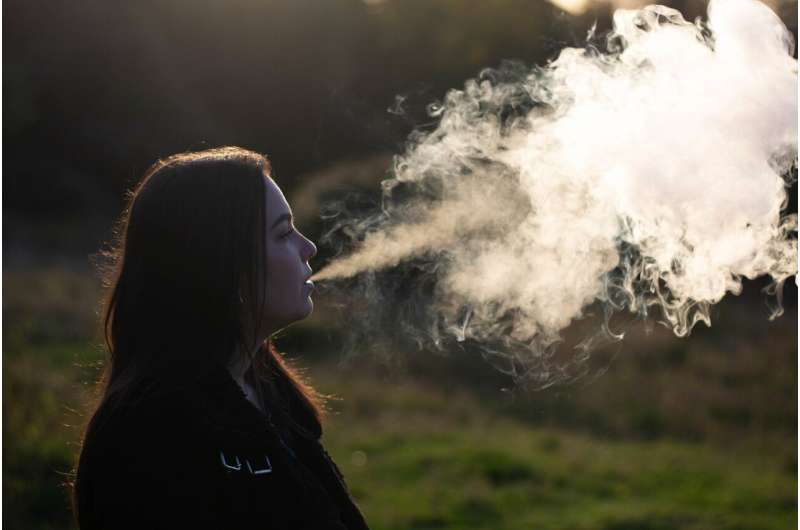This article has been reviewed according to Science X's editorial process and policies. Editors have highlighted the following attributes while ensuring the content's credibility:
fact-checked
trusted source
proofread
Study finds most young people have been exposed to vaping ads, despite restrictions

Three quarters of young Australians who are aware of vaping have seen e-cigarette advertising, according to a new study by The George Institute for Global Health. The research findings were published in the journal Tobacco Induced Diseases.
An international study of more than 4,000 people aged 15–30 showed that the most common real-life settings where the 1,006 Australian respondents saw advertising were vape shops (45%), tobacconists (35%) and general retailers like supermarkets, corner shops and petrol stations (23%).
But perhaps more concerning is the role social media is playing in the e-cigarette marketing playbook—1 in 3 (31%) respondents had seen vape ads on TikTok and Instagram, 1 in 4 had seen ads on Snapchat (25%) and Facebook (24%), and 1 in 5 had seen ads on YouTube (22%).
Professor Simone Pettigrew, lead author and Program Director of Health Promotion and Behavior Change at The George Institute said "Digital forms of e-cigarette promotion are particularly difficult to monitor and control, and the vaping industry is exploiting this opportunity to target young people.
"Our previous research showed that more than half (54%) of young Aussies are susceptible to taking up vaping, and exposure to advertising was strongly associated with this susceptibility."
In the present study, Australian e-cigarette users reported seeing advertising at more than twice the rate of those who have never vaped on all social media channels assessed—Instagram, YouTube, Facebook, TikTok, Snapchat, Twitter (now known as X), and Pinterest.
Researchers also identified an association between the number of different types of media exposure and vaping. Every additional exposure to a source of advertising, such as in a physical location or on a social media platform, increased the likelihood of using e-cigarettes by an additional 5%.
"It's possible that e-cigarette users are more receptive to advertising than non-users, or that social media algorithms may be targeting ads to those who vape, leading to increased exposure amongst current users," Prof Pettigrew added.
A recent report by VicHealth3 looking into the online marketing tactics of the vaping industry found many TikTok and Instagram accounts that post vaping content are masquerading as individual accounts but are actually directly linked to an online e-cigarette store.
The report also found that the vaping industry is increasingly using social media influencers, with Instagram home to more than 18,000 Australian "vaping influencer" profiles solely dedicated to promoting vaping.
Australia's eSafety commissioner estimates that in 2020, Australian teens spent an average of 14.4 hours a week online. They used an average of four different social media services, with YouTube, Instagram, Facebook and Snapchat being the most popular. TikTok has shown the greatest growth, used by 12% of teens in 2017, increasing to 38% in 2020.
Professor Pettigrew added that the high rates of exposure seen across all types of media were remarkable given the regulations that are currently in place in Australia, where advertising prescription medicines, including nicotine vaping products, to consumers is generally prohibited.
"That's why we fully support the Federal Government's commitment to updating legislation to outlaw the importation of non-prescription vaping products and proposed regulations requiring vaping products to come with warning labels, in restricted flavors, and in plain pharmaceutical packaging, to help protect our younger generations from vaping harms."
"But the pervasive nature of e-cigarette advertising online shows that regulations are only as good as the measures that enforce them. So we would endorse a tough approach to those who flout the rules, including substantial fines for the e-cigarette, advertising, and social media companies that break them."
More information: Simone Pettigrew et al, Exposure to e-cigarette advertising and young people's use of e-cigarettes: A four-country study, Tobacco Induced Diseases (2023). DOI: 10.18332/tid/172414


















